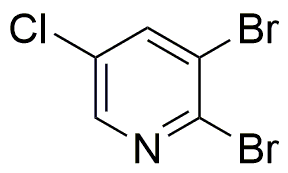2,3-Dibromo-5-chloropyridine is widely utilized in research focused on:
- Pesticide Development: This compound serves as a key intermediate in the synthesis of novel agrochemicals, particularly in creating effective pesticides that target specific pests while minimizing environmental impact.
- Pharmaceutical Research: It is explored for its potential in developing new pharmaceuticals, especially in the field of antimicrobial agents, where its unique structure can enhance efficacy against resistant strains.
- Material Science: The compound is used in the formulation of advanced materials, including polymers and coatings, that require specific chemical properties for improved durability and performance.
- Analytical Chemistry: It acts as a reference standard in various analytical techniques, aiding researchers in the accurate identification and quantification of similar compounds in complex mixtures.
- Organic Synthesis: The compound is a valuable building block in organic synthesis, allowing chemists to create more complex molecules efficiently, which is crucial in both academic and industrial settings.
General Information
Properties
Safety and Regulations
Applications
2,3-Dibromo-5-chloropyridine is widely utilized in research focused on:
- Pesticide Development: This compound serves as a key intermediate in the synthesis of novel agrochemicals, particularly in creating effective pesticides that target specific pests while minimizing environmental impact.
- Pharmaceutical Research: It is explored for its potential in developing new pharmaceuticals, especially in the field of antimicrobial agents, where its unique structure can enhance efficacy against resistant strains.
- Material Science: The compound is used in the formulation of advanced materials, including polymers and coatings, that require specific chemical properties for improved durability and performance.
- Analytical Chemistry: It acts as a reference standard in various analytical techniques, aiding researchers in the accurate identification and quantification of similar compounds in complex mixtures.
- Organic Synthesis: The compound is a valuable building block in organic synthesis, allowing chemists to create more complex molecules efficiently, which is crucial in both academic and industrial settings.
Documents
Safety Data Sheets (SDS)
The SDS provides comprehensive safety information on handling, storage, and disposal of the product.
Product Specification (PS)
The PS provides a comprehensive breakdown of the product’s properties, including chemical composition, physical state, purity, and storage requirements. It also details acceptable quality ranges and the product's intended applications.
Certificates of Analysis (COA)
Search for Certificates of Analysis (COA) by entering the products Lot Number. Lot and Batch Numbers can be found on a product’s label following the words ‘Lot’ or ‘Batch’.
Numéro de catalogue
Numéro de lot/série
Certificates Of Origin (COO)
This COO confirms the country where the product was manufactured, and also details the materials and components used in it and whether it is derived from natural, synthetic, or other specific sources. This certificate may be required for customs, trade, and regulatory compliance.
Numéro de catalogue
Numéro de lot/série
Safety Data Sheets (SDS)
The SDS provides comprehensive safety information on handling, storage, and disposal of the product.
DownloadProduct Specification (PS)
The PS provides a comprehensive breakdown of the product’s properties, including chemical composition, physical state, purity, and storage requirements. It also details acceptable quality ranges and the product's intended applications.
DownloadCertificates of Analysis (COA)
Search for Certificates of Analysis (COA) by entering the products Lot Number. Lot and Batch Numbers can be found on a product’s label following the words ‘Lot’ or ‘Batch’.
Numéro de catalogue
Numéro de lot/série
Certificates Of Origin (COO)
This COO confirms the country where the product was manufactured, and also details the materials and components used in it and whether it is derived from natural, synthetic, or other specific sources. This certificate may be required for customs, trade, and regulatory compliance.


